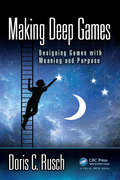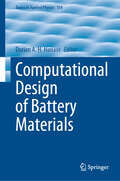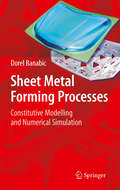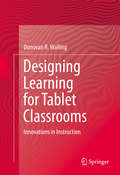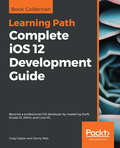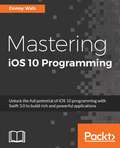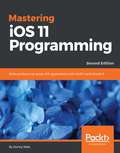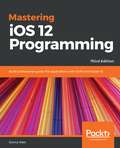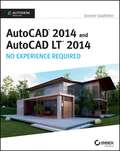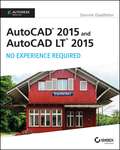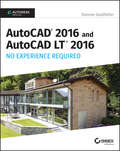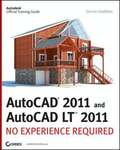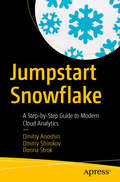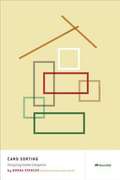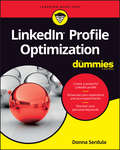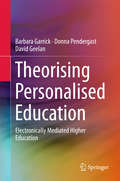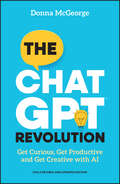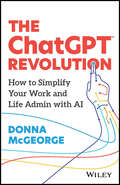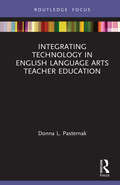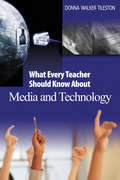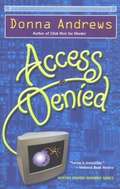- Table View
- List View
Making Deep Games: Designing Games with Meaning and Purpose
by Doris C. RuschLike movies, television, and other preceding forms of media, video games are undergoing a dynamic shift in its content and perception. While the medium can still be considered in its infancy, the mark of true artistry and conceptual depth is detectable in the evolving styles, various genres and game themes. Doris C. Rusch’s, Making Deep Games, combines this insight along with the discussion of the expressive nature of games, various case studies, and hands-on design exercises. This book offers a perspective into how to make games that tackle the whole bandwidth of the human experience; games that teach us something about ourselves, enable thought-provoking, emotionally rich experiences and promote personal and social change. Grounded in cognitive linguistics, game studies and the reflective practice of game design, Making Deep Games explores systematic approaches for how to approach complex abstract concepts, inner processes, and emotions through the specific means of the medium. It aims to shed light on how to make the multifaceted aspects of the human condition tangible through gameplay experiences.
Computational Design of Battery Materials (Topics in Applied Physics #150)
by Dorian A. H. HanaorThis book presents an essential survey of the state of the art in the application of diverse computational methods to the interpretation, prediction, and design of high-performance battery materials. Rechargeable batteries have become one of the most important technologies supporting the global transition from fossil fuels to renewable energy sources. Aided by the growth of high-performance computing and machine learning technologies, computational methods are being applied to design the battery materials of the future and pave the way to a more sustainable energy economy. In this contributed collection, leading battery material researchers from across the globe share their methods, insights, and expert knowledge in the application of computational methods for battery material design and interpretation. With chapters featuring an array of computational techniques applied to model the relevant properties of cathodes, anodes, and electrolytes, this book provides the ideal starting point for any researcher looking to integrate computational tools in the development of next-generation battery materials and processes.
Sheet Metal Forming Processes
by Dorel BanabicThe book gives a synthetic presentation of the research performed in the field of sheet metal forming simulation during more than twenty years by the members of three teams: the Research Centre on Sheet Metal Forming - CERTETA (Technical University of Cluj-Napoca, Romania); AUTOFORM software-house company from Zürich, Switzerland and VOLVO automotive company from Sweden. The first chapter reminds some fundamental topics of the theory of plasticity. A more extended chapter is devoted to the presentation of the phenomenological yield criteria, emphasizing the formulations proposed by the CERTETA team (BBC models). The sheet metal formability is discussed in a separate chapter. After presenting the methods used for the formability assessment, the discussion focuses on the forming limit curves. In this context, the authors emphasize their contributions to the mathematical modeling of forming limit curves. The aspects related to the implementation of the constitutive models in finite-element codes are discussed in the last chapter of the book. The performances of the models are proved by the numerical simulation of various sheet metal forming processes: hydroforming, deep-drawing and forming of the complex parts. The book is useful for the students, doctoral fellows, researchers and engineers who are mainly interested in the mechanical modeling and numerical simulation of sheet metal forming processes. Modeling and numerical simulation of sheet metal forming processes.
Designing Learning for Tablet Classrooms
by Donovan R. WallingThe versatile, cost-effective technology of the tablet computer has proved to be a good fit with the learning capabilities of today's students. Not surprisingly, in more and more classrooms, the tablet has replaced not only traditional print materials but the desktop computer and the laptop as well. Designing Instruction for Tablet Classrooms makes sense of this transition, clearly showing not just how and why tablet-based learning works, but how it is likely to evolve. Written for the non-technical reader, it balances elegant theoretical background with practical applications suitable to learning environments from kindergarten through college. A wealth of specialized topics ranges from course management and troubleshooting to creating and customizing etextbooks, from tablet use in early and remedial reading to the pros and cons of virtual field trips. And for maximum usefulness, early chapters are organized to spotlight core skills needed to negotiate the new design frontier, including: Framing the learning design approach. Analyzing the learning environment. Designing learning that capitalizes on tablet technology. Developing activities that match learning needs. Implementing the learning design. Conducting evaluations before, during, and after. This is proactive reading befitting a future of exciting developments in educational technology. For researchers and practitioners in this and allied fields, Designing Instruction for Tablet Classrooms offers limitless opportunities to think outside the box.
Complete iOS 12 Development Guide: Become a professional iOS developer by mastering Swift, Xcode 10, ARKit, and Core ML
by Donny Wals Craig ClaytonLearn to create professional-grade iOS applications for the App Store using the latest iOS 12 features and other helpful tools Key Features Explore the distinctive design principles that define the iOS user experience Train and use machine learning models with Core ML 2 and Create ML Delve into advanced animations with UIViewPropertyAnimator and UIKitDynamics Book Description With Apple users spending more money in the App Store, there are plenty of development opportunities for professional iOS developers. This Learning Path is a direct route to iOS development, which will take you through the basics and help you put principles into practice. For experienced programmers, this book will help you gain insights into the latest iOS 12 features. This book is also useful for beginners who want to gain expertise in iOS development. You'll start with an introduction to iOS development, Xcode, and Swift. To give your app the edge, you'll get up to speed with advanced iOS topics, such as gestures and animations. Next, you will understand the latest Swift 4.2 and iOS 12 developments by incorporating new features, such as the latest in notifications, custom-UI notifications, maps, and recent additions in SiriKit. With these tools, you'll be able to write efficient, readable, and maintainable Swift code that maintains industry best practices. By the end of the book, you will have the confidence to build iOS 12 applications that harness advanced techniques and make the best use of the latest features. This Learning Path includes content from the following Packt products: iOS 12 Programming for Beginners - Third Edition by Craig Clayton Mastering iOS 12 Programming - Third Edition by Donny Wals What you will learn Build a responsive user interface (UI) and add privacy to your custom-rich notifications Set up SiriKit to add voice for Siri shortcuts Integrate iMessage, Siri, and more in your app through app extensions Use TestFlight to collect feedback before releasing your apps on the App Store Use Auto Layout to create complex layouts that look visually appealing on any device Enhance your app by building your own profiling tools Create engaging augmented reality experiences with ARKit 2 Who this book is for If you are completely new to Swift, iOS, or programming and want to become an expert in developing iOS applications, this Learning Path is for you. You'll also find this Learning Path useful if you're an experienced programmer looking to explore the latest iOS 12 features.
Mastering iOS 10 Programming
by Donny WalsUnlock the full potential of iOS 10 programming with Swift 3.0 to build rich and powerful applications About This Book • This practical guide will help you make the transition to professional iOS developer • Implement numerous powerful iOS 10 and Swift 3 techniques to build high-quality apps through this book • Get the most in-depth, advanced-level guide on the latest version of iOS and take a hands-on approach Who This Book Is For This book is for developers who have some experience with iOS and want to take their skills to next level by unlocking the full potential of latest version of iOS with Swift to build impressive applications. What You Will Learn • Write beautiful Swift code with Protocol-Oriented Programming and best practices • Create rich views and layouts with responsive animations and transitions. • Handle data, both from the web and offline • Integrate with iOS and improve the user experience with app extensions • Make sure that your app is of outstanding quality with XCTest • Measure and improve performance by using Xcode Instruments • Embrace the latest extension features in iOS 10 such as the new rich notifications, SiriKit, and iMessage In Detail With usage of apps growing rapidly, mobile application development has become the most sought-after skill set. Within the mobile market, iOS commands a massive presence and is a highly lucrative platform. The goal of our book is to help you become a professional developer by unleashing the full potential of iOS 10 to build applications. Written with the latest Swift version and following the latest Swift API design guidelines, you won't just learn how to program for iOS 10—you'll also learn how to write beautiful, readable, and maintainable Swift code that's in line with the industry's best-practices. The progression of the book reflects the real-world development flow: it will quickly brush on the essentials at the beginning and then move on to the advanced concepts crucial to building powerful applications. Within the book, you will build a couple of small applications that resemble applications you might want to build in the real world. You will be reading a mix of thorough background information and practical examples, so you'll know how to make use of a certain technique right away while you also get a great understanding of the how and why. Style and approach This book takes a no-frill approach and is very code-specific. The focus is on teaching advanced concepts through a series of small projects and standalone examples that help you gain expertise with various aspects of iOS application development.
Mastering iOS 11 Programming - Second Edition
by Donny WalsTransition to a Professional iOS developer with the most in-depth and advanced level guide on Swift 4 and Xcode 9 About This Book • Filled with practical examples, this comprehensive guide explores all aspects of iOS Development. • Learn powerful techniques and industry`s best practices to become pro iOS Developer. • Unlock the full potential of iOS 11 programming with Swift 4 to build rich and powerful applications • Gain detailed insights into core iOS Programming concepts such as Extensions, Performance, Animations, CoreData and lot more with examples • Extend your iOS apps to new level with ARKit and CoreML Who This Book Is For This book is for developers who have some experience with iOS programming, but want to take their skills to next level by unlocking the full potential of latest version of iOS with Swift to build great applications. What You Will Learn • Build a professional iOS application from scratch • Create adaptive, complex views with Auto-Layout • Writing flexible and reusable code with Protocol Oriented programming • Ensure code quality by using proper tests. • Measure and improve performance with the Instruments app • Integrate with iOS on a deep level with several App Extensions • Implement AI, Machine Learning, Augmented Reality and more iOS 11 sweetness In Detail With good pay for iOS developers, a mature development environment, and Apple users spending more money on the App store than Android users, becoming a professional iOS developer is a great move. The journey to master iOS development and the new features of iOS 11 is not straightforward, but this book will help you make that transition. Written for Swift 4 and following the latest Swift API design guidelines, you won't just learn how to program for iOS 11, you'll learn how to write great, readable, and maintainable Swift code that's in line with the industry's best-practices. The progression of this book reflects the real-world development flow. In the book, you will build real-world applications. You will find a mix of thorough background information and practical examples, so you'll know how to make use of a technique right away while you also get a great understanding of the how and why. By the end, you will be able to build iOS applications that harness advanced techniques and make the best use of the latest and greatest features available in iOS 11. Style and approach This book takes a no-frill approach and is very code-specific. The focus is on teaching advanced concepts through a series of small projects and standalone examples that help you gain expertise with various aspects of iOS application development.
Mastering iOS 12 Programming: Build professional-grade iOS applications with Swift and Xcode 10, 3rd Edition
by Donny WalsBecome a professional iOS developer with the most in-depth and advanced guide to Swift, Xcode 10, ARKit, and Core MLKey FeaturesExplore the extensive world of iOS development through practical examplesGain detailed insights into core iOS programming concepts such as app extensions and performanceExtend your iOS apps by adding augmented reality and machine learning capabilitiesBook DescriptionThe iOS development environment has significantly matured, and with Apple users spending more money in the App Store, there are plenty of development opportunities for professional iOS developers. However, the journey to mastering iOS development and the new features of iOS 12 is not straightforward. This book will help you make that transition smoothly and easily. With the help of Swift 4.2, you’ll not only learn how to program for iOS 12, but also how to write efficient, readable, and maintainable Swift code that maintains industry best practices. Mastering iOS 12 Programming will help you build real-world applications and reflect the real-world development flow. You will also find a mix of thorough background information and practical examples, teaching you how to start implementing your newly gained knowledge. By the end of this book, you will have got to grips with building iOS applications that harness advanced techniques and make best use of the latest and greatest features available in iOS 12.What you will learnBuild a professional iOS application using Xcode 10 and Swift 4.2Use AutoLayout to create complex layouts that look great on every deviceDelve into advanced animations with UIViewPropertyAnimator and UIKit DynamicsEnhance your app by using instruments and building your own profiling toolsIntegrate iMessage, Siri, and more in your app through app extensionsTrain and use machine learning models with Core ML 2 and Create MLCreate engaging augmented reality experiences with ARKit 2Who this book is forIf you’re a developer with some experience in iOS programming and want to enhance your skills by unlocking the full potential of the latest iOS version with Swift to build great applications, this book is for you.
The Cybersecurity Trinity: Artificial Intelligence, Automation, and Active Cyber Defense
by Donnie W. WendtThis book explores three crucial topics for cybersecurity professionals: artificial intelligence (AI), automation, and active cyber defense (ACD). The Cybersecurity Trinity will provide cybersecurity professionals with the necessary background to improve their defenses by harnessing the combined power of these three concepts. The book is divided into four sections, one addressing each underlying concept and the final section discussing integrating them to harness their full potential. With the expected growth of AI and machine learning (ML), cybersecurity professionals must understand its core concepts to defend AI and ML-based systems. Also, most cybersecurity tools now incorporate AI and ML. However, many cybersecurity professionals lack a fundamental understanding of AI and ML. The book's first section aims to demystify AI and ML for cybersecurity practitioners by exploring how AI and ML systems work, where they are vulnerable, and how to defend them. Next, we turn our attention to security automation. Human-centered cyber defense processes cannot keep pace with the threats targeting organizations. Security automation can help defenders drastically increase the speed of detection and response. This section will discuss core use cases that security teams can implement, including intelligence processing, incident triage, detection, and response. This section will end with strategies for a successful security automation implementation and strategies that can lead to failure. Accelerating the defense is but one side of the equation. Defenders can also implement ACD methods to disrupt and slow the attacker. Of course, ACD spans a broad spectrum, including some that could raise legal and ethical concerns. This section will explore some ACD methods and discuss their applicability, as well as the need to include business, legal, and ethical considerations when implementing them. Security teams often treat AI, automation, and ACD as disparate solutions, addressing specific problems. However, there is much overlap, and security teams must develop a cohesive approach to realize the full potential. The last section combines these three concepts to form a comprehensive strategy. The resulting strategy will have AI as the foundation, incorporating automation to speed up defense and ACD to disrupt the attacker. What You Will Learn: Understand the many uses of AI and ML and the concepts underpinning these technologies. Learn how to protect AI and ML systems by recognizing the vulnerabilities throughout their lifecycle. Integrate AI and ML-based systems to enhance cybersecurity. Develop security automation processes to enhance situation awareness, speed the time to respond, and increase the bandwidth of the limited security operations staff. Develop an ACD strategy to slow the attackers while minimizing legal and ethical concerns. Design a comprehensive strategy with AI as the foundation, incorporating automation to speed up defense and ACD to disrupt the attacker. Who This Book is for: The primary audience is cybersecurity professionals looking to improve their organization's security posture by leveraging AI and ML-based security tools and combining them into a comprehensive strategy incorporating automation and ACD. This target audience will have a cybersecurity background and an interest in AI and ML. Higher education would be a secondary audience.
AutoCAD 2012 and AutoCAD LT 2012
by Donnie GladfelterThe perfect step-by-step introduction to Autodesk's powerful architectural design softwareWith this essential guide, you'll learn how to plan, develop, document, and present a complete AutoCAD project by building a summer cabin from start to finish. You can follow each step sequentially or jump in at any point by downloading the drawing files from the book's companion web site. You'll also master all essential AutoCAD features, get a thorough grounding in the basics, learn the very latest industry standards and techniques, and quickly become productive with AutoCAD 2012.Features concise explanations, focused examples, and step-by-step instructions for learning AutoCAD and AutoCAD LT in a hands-on project that runs throughout the bookAddresses the newest features of AutoCAD 2012 and AutoCAD LT 2012 as well as emerging techniques and standards in the industryBegins with the basics such as the AutoCAD interface, basic commands, and creating drawings and gradually progresses to more advanced topics, including grouping, elevations, hatches, and using text in drawingsIntroduces dimensioning, external references, layouts and printing, and using 3DAutoCAD and AutoCAD LT: No Experience Required helps you quickly learn to use AutoCAD and AutoCAD LT right away.
AutoCAD 2015 and AutoCAD LT 2015: No Experience Required
by Donnie GladfelterLearn AutoCAD by example with this tutorial-based guide from Autodesk Official PressWhether you are just starting out or an experienced user wanting to brush up on your skills, this Autodesk Official Press book provides you with concise explanations, focused examples, and step-by-step instructions through a hands-on tutorial project that runs throughout the book. As you progress through the project, the book introduces you to the Microsoft Windows-based AutoCAD interface and then guides you through basic commands and creating drawings. A downloadable file is available from the website so that you can compare your work to the author's, and if necessary, start fresh with an intact drawing. Once you've completed the project, you will have proficiency in AutoCAD skills including:Grouping, elevations, and hatchesUsing text in drawingsDimensioningExternal referencesLayouts and printingUsing 3DAuthor Donnie Gladfelter (aka "The CAD Geek"), is a top-rated trainer at CADD Microsystems and has worked with the Autodesk development team to help shape the product features. He is an AutoCAD Mentor All Star and has been a popular speaker at Autodesk University for more than seven years.
AutoCAD 2016 and AutoCAD LT 2016 No Experience Required
by Donnie GladfelterHands-on AutoCAD training in a tutorial-driven beginner's guide AutoCAD 2016 and AutoCAD LT 2016: No Experience Required is your ultimate beginner's guide to the leading drawing and design software. Using a continuous tutorial approach, this book walks you step-by-step through the entire design process from setup to printing. Follow the tutorial from start to finish, or jump in at any time to pick up new skills. The companion website features downloadable tutorial files that allow you to join the project at each progress point, and the short discussions and intensively hands-on instruction allow you to instantly see the results of your work. You'll start by learning the basics as you create a simple 2D drawing, and then gradually build upon your skills by adding detail, dimensions, text, and more. You'll learn how to create an effective presentation layout, and how to turn your drawing into a 3D model that can help you pinpoint design flaws and features. AutoCAD's newest commands and capabilities are reinforced throughout, so you can gain confidence and build a skillset to be proud of. Get acquainted with the AutoCAD 2016 interface and basic commands Create accurate drawings and elevations to communicate your design Add detail to your plans with groupings, hatches, text, and dimensions Lay your design out for printing, or go 3D to create a walk-through model AutoCAD 2016 and AutoCAD LT 2016: No Experience Required gets you started, so you can begin designing today.
AutoCAD® 20011 and AutoCAD LT® 2011 No Experience Required
by Donnie GladfelterA step-by-step tutorial on AutoCAD and AutoCAD LT basics AutoCAD is the leading drawing software, used by design and drafting professionals to create 2D and 3D technical drawings. This tutorial is aimed at AutoCAD novices and provides you with the essentials you need so you can acquire the necessary skills to work in AutoCAD and AutoCAD LT immediately. You'll begin with the basics and gradually progress to more advanced topics and features, such as grouping, elevations, hatches, and using text in drawings. Concise explanations, focused examples, and step-by-step instructions round out this hands-on tutorial. Begins with the basics of AutoCAD and AutoCAD LT, the leading 2D and 3D drawing software Progresses to more advanced topics and skill sets and covers grouping, hatches, and text in drawings Introduces dimensioning, external references, layouts and printing, and using 3D Contains helpful examples and step-by-step instructions so you can get started using AutoCAD immediately Featuring the most up-to-date techniques, tactics, industry standards, and methods, this tutorial will get you started using AutoCAD and AutoCAD LT right away.
Jumpstart Snowflake: A Step-by-Step Guide to Modern Cloud Analytics
by Dmitry Anoshin Dmitry Shirokov Donna StrokExplore the modern market of data analytics platforms and the benefits of using Snowflake computing, the data warehouse built for the cloud. With the rise of cloud technologies, organizations prefer to deploy their analytics using cloud providers such as Amazon Web Services (AWS), Microsoft Azure, or Google Cloud Platform. Cloud vendors are offering modern data platforms for building cloud analytics solutions to collect data and consolidate into single storage solutions that provide insights for business users. The core of any analytics framework is the data warehouse, and previously customers did not have many choices of platform to use. Snowflake was built specifically for the cloud and it is a true game changer for the analytics market. This book will help onboard you to Snowflake, present best practices to deploy, and use the Snowflake data warehouse. In addition, it covers modern analytics architecture and use cases. It provides use cases of integration with leading analytics software such as Matillion ETL, Tableau, and Databricks. Finally, it covers migration scenarios for on-premise legacy data warehouses. What You Will Learn Know the key functionalities of SnowflakeSet up security and access with clusterBulk load data into Snowflake using the COPY commandMigrate from a legacy data warehouse to Snowflakeintegrate the Snowflake data platform with modern business intelligence (BI) and data integration tools Who This Book Is For Those working with data warehouse and business intelligence (BI) technologies, and existing and potential Snowflake users
Card Sorting
by Donna SpencerCard sorting helps us understand how people think about content and categories. Armed with this knowledge, we can group information so that people can better find and understand it. In this book, Donna describes how to plan and run a card sort, then analyse the results and apply the outcomes to your project.
LinkedIn Profile Optimization For Dummies
by Donna SerdulaOptimize your LinkedIn profile--and get results Your LinkedIn profile is essentially a platform to shape how others see you, highlight your abilities, products, or services, and explain how your work impacts lives. Yet many people simply copy and paste their resume and expect job offers and networking opportunities to start rolling in--but that isn't how it works. LinkedIn Profile Optimization For Dummies shows you how to create a profile that enhances your personal brand, controls how others see you, and shapes a successful future for your career. Whether your goal is job search, branding, reputation management, or sales, people are Googling you--and your LinkedIn profile is more often than not their first point of contact. With a focus on who you are, the value you deliver, and the culture you cultivate, the profile you'll create with the help of this guide will make that first connection a positive one--giving you a better chance to see results. Create a powerful LinkedIn profile Discover your personal keywords Showcase your experience and accomplishments Be seen on the world's largest professional social network You never get a second chance to make a great first impression, and LinkedIn Profile Optimization For Dummies helps to ensure you're presenting yourself in the best possible light.
Theorising Personalised Education
by Barbara Garrick Donna Pendergast David GeelanThis book examines the theoretical underpinning of the concept of personalised education and explores the question: What is personalised education in the contemporary higher education sector and how is it implemented? A broad, sophisticated definition of personalised learning has the potential to serve as a basis for more effective educational practices. The term 'personalised education' is, and continues to be, one with a variety of definitions. The authors' definition both incorporates earlier concepts of personalised education and critically reassesses them. The book then adds a further dimension: personalised instruction in electronically mediated environments, where the goal is to achieve learning towards mastery individually with the help of differentiated and individualised electronic learning platforms. This book assesses the various arguments concerning personalised education, examining each through the lens of educational theory and pedagogy and subsequently positing a number of qualitative characteristics of personalised education that have the potential to influence policy and practices in the higher education sector.
The ChatGPT Revolution: Get Curious, Get Productive and Get Creative with AI
by Donna McGeorgeLearn how to simplify your life with AI in this essential guide — now fully updated and revised, with even more ideas to spark creativity and boost efficiency The ChatGPT Revolution is the ultimate quick-start guide to unlocking the power of generative AI. We’re on the edge of an AI revolution … but what does that mean for you? It’s time to get curious about how the latest tech can help you handle your everyday load, at work and at home! Whether you’re overwhelmed by repetitive, time-consuming tasks or you’re simply looking for a fresh injection of creativity, ChatGPT has got your back. With this essential handbook, you’ll learn how quickly and easily apps like ChatGPT can turn your to-do list into a ta-da list. From emails and reports to planning your next meal or vacation, generative AI can help you simplify your daily tasks and responsibilities. The ChatGPT Revolution shows you exactly how to use this innovative tech to save on time and stress. Sharing practical tips and fun ideas, acclaimed productivity expert Donna McGeorge unpacks everything you need to know. Learn how generative AI is already being used in everyday life — and how tools like ChatGPT are transforming the future of work and life admin Understand the different tasks that AI tools like ChatGPT, Copilot, and DALL-E can do — and when and how to use these tools most effectively Get step-by-step advice for writing smart, specific prompts and follow-up queries to produce better results Discover tips for using ChatGPT on the go, with the mobile app and voice and photo capability Take control, revitalise your workflows, and overcome procrastination and creative blocks — with entertaining examples and activities for work, home, creative writing, and more Whether you’re a busy professional or you simply want an answer to the dreaded question ‘What’s for dinner?,’ The ChatGPT Revolution reveals how generative AI can make your life easier. AI technologies are here to stay. This is your invitation to join the revolution. Pick up this book and learn how to harness the power of AI, so you can free up more time and energy for the things that truly matter.
The ChatGPT Revolution: How to Simplify Your Work and Life Admin with AI
by Donna McGeorgeThe essential guide to using AI in your everyday life The ChatGPT Revolution is the ultimate quick-start guide to unlocking the power of AI tool ChatGPT. We’re on the edge of an AI revolution… but what does that mean for you? It’s time to get curious about how the latest tech can help you handle your everyday load, at work and at home! Whether you’re overwhelmed by repetitive, time-consuming tasks or you’re simply looking for a fresh injection of creativity, ChatGPT is the virtual assistant that’s got your back. With this essential handbook, you’ll learn how quickly and easily ChatGPT can turn your to-do list into a ta-da list. From helping you write emails and reports to planning your next meal or vacation, ChatGPT offers a new way to simplify your daily tasks and responsibilities. The ChatGPT Revolution shows you exactly how to use this innovative tech to save on time and stress. Sharing practical tips and fun ideas, author and acclaimed productivity expert Donna McGeorge unpacks everything you need to know. Learn how AI is already being used in everyday life — and how tools like ChatGPT are transforming the future of work and life admin Understand the different tasks ChatGPT can do and when and how to use it most effectively Get step-by-step advice for writing smart, specific prompts and follow-up queries that will produce better results Get curious and get productive, with entertaining examples, advice, and activities to take control, revitalise your workflows, and overcome procrastination and creative blocksWhether you’re a busy professional or you simply want an answer to the dreaded question ‘What’s for dinner?,’ The ChatGPT Revolution reveals how you can use ChatGPT as a tool to simplify your life. AI technologies are here to stay: this is your invitation to join the revolution. Pick up this book and learn how to harness the power of AI, so you can free up more time and energy for the things that truly matter.
Integrating Technology in English Language Arts Teacher Education (Routledge Research in Teacher Education)
by Donna L. PasternakIntegrating Technology in English Language Arts Teacher Education investigates the technology practices teacher candidates in the US are being introduced to, how they are using these practices in classrooms, and how technology can be effectively integrated into English teacher education programs. By drawing upon findings from extensive longitudinal studies into teacher education programs in the US, this timely volume addresses critical themes relating to the integration of technology in education, including: • Teaching with technology • Technology for collaboration • Technology for individualized learning and assessment By analyzing the experiences of teacher educators and candidates, and offering detailed analysis of the content, practices, and skills being taught to pre-service English teachers, Pasternak examines the entities that drive or inhibit the adoption of technology into the secondary English language arts (ELA) curriculum. This volume will resonate with an international audience of post-graduate scholars and researchers interested in the fields of teacher education, English language arts, and the relationship between technology and classroom practice.
Computer Accounting with QuickBooks Online
by Donna KayGain a competitive advantage – learn a leading online financial app for entrepreneurs with Computer Accounting with QuickBooks Online. Designed using the most effective way to learn QuickBooks Online, this text streamlines learning QuickBooks Online because it focuses on you―the learner. Proven instructional techniques are incorporated throughout the text to make your mastery of QuickBooks Online as effortless as possible. Using a hands-on approach, this text integrates understanding accounting with mastery of QuickBooks Online. Designed for maximum flexibility to meet your needs, Computer Accounting with QuickBooks Online can be used either in a QuickBooks Online course or independently at your own pace.
The Happiness Effect: How Social Media is Driving a Generation to Appear Perfect at Any Cost
by Donna Freitas Christian SmithSexting. Cyberbullying. Narcissism. Social media has become the dominant force in young people's lives, and each day seems to bring another shocking tale of private pictures getting into the wrong hands, or a lament that young people feel compelled to share their each and every thought with the entire world. Have smartphones and social media created a generation of self-obsessed egomaniacs? <p>Absolutely not, Donna Freitas argues in this provocative book. And, she says, these alarmist fears are drawing attention away from the real issues that young adults are facing.
What Every Teacher Should Know About Media and Technology
by Donna E. TilestonTechnology plus classroom can equal success for students. This invaluable resource for teachers presents classroom applications of media, technology, and the Internet.
Offline
by Donna CoonerIn this e-book original, acclaimed author Donna Cooner spins a timely and gripping story of how we live our lives on -- and off -- social media.Annie Webb is constantly online. She loves following influencer accounts, DM'ing with her two best friends, Luna and Caitlin, and posting selfies with her adorable boyfriend, Jameson.Then Jameson breaks up with Annie -- online. The public humiliation is immediate and intense, and Annie is overwhelmed by the cruel comments that pour in. To help Annie cope, Luna and Caitlin make a plan: the three of them will stay off social media for a month. No posting. No scrolling. No cheating.But unplugging is much harder than they thought. And when the rest of their school finds out about their offline challenge, can the three girls keep their vow -- and their friendship?
Access Denied (Turing Hopper #3)
by Donna AndrewsWhen Turing Hopper, Artificial Intelligence Personality extraordinaire, learns that criminal Nestor Garcia's once-dormant credit card has been doing a lot of shopping lately, she begins to do some sleuthing -- and finds out the loot's shown up at an empty bungalow. So Turing gets her human friends to stake out the vicinity. But when one of them sees something he wishes he hadn't -- and gets charged with murder -- everyone will have to pull together to clear his name. The only way to do it is to find the guilty party -- by luring him to attack them. But doing so might very well get them "accidentally" deleted...
